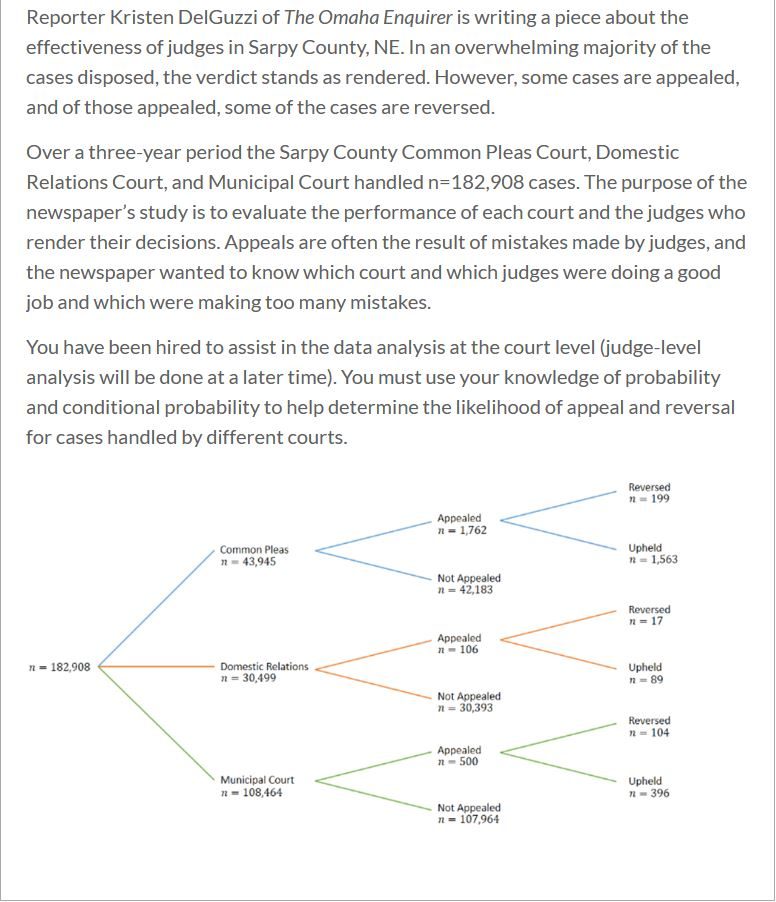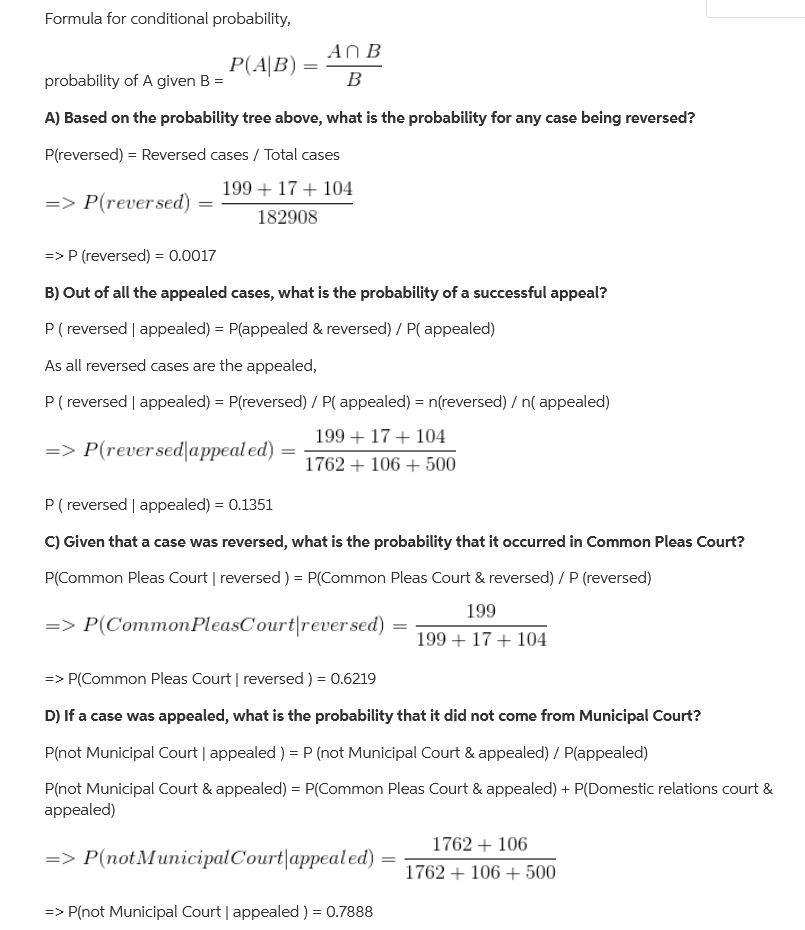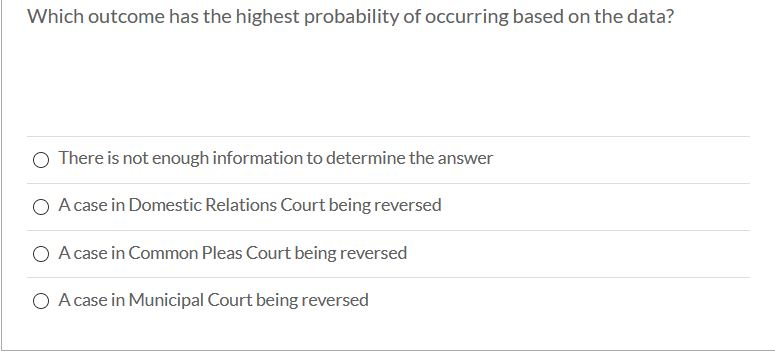I just need the part answered that has the multiple choice. It is related to the problem below and the 4 already answered questions.


This is the question that needs answered base upon the above information. Thanks.

Reporter Kristen DelGuzzi of The Omaha Enquirer is writing a piece about the effectiveness of judges in Sarpy County, NE. In an overwhelming majority of the cases disposed, the verdict stands as rendered. However, some cases are appealed, and of those appealed, some of the cases are reversed. Over a three-year period the Sarpy County Common Pleas Court, Domestic Relations Court, and Municipal Court handled n=182,908 cases. The purpose of the newspaper's study is to evaluate the performance of each court and the judges who render their decisions. Appeals are often the result of mistakes made by judges, and the newspaper wanted to know which court and which judges were doing a good job and which were making too many mistakes. You have been hired to assist in the data analysis at the court level (judge-level analysis will be done at a later time). You must use your knowledge of probability and conditional probability to help determine the likelihood of appeal and reversal for cases handled by different courts. Reversed 1199 Appealed 1,762 Common Pleas 43,945 Upheld n=1,563 1 Not Appealed n = 42,183 Reversed n-17 Appealed n106 n = 182.908 Domestic Relations n = 30,499 Upheld n89 Not Appealed n = 30,393 Reversed n=104 Appealed n 500 Municipal Court n = 108,464 Upheld 1396 Not Appealed n-107,964 Formula for conditional probability, ANB P(AB) = ? probability of A given B = A) Based on the probability tree above, what is the probability for any case being reversed? P(reversed) = Reversed cases / Total cases 199 + 17 + 104 => P(reversed) = = 182908 => P (reversed) = 0.0017 B) Out of all the appealed cases, what is the probability of a successful appeal? P(reversed | appealed) = Pappealed & reversed) / P( appealed) As all reversed cases are the appealed, P (reversed | appealed) = P(reversed) / P( appealed) = n(reversed)( appealed) 199 + 17 + 104 => P(rever sed appealed) = 1762 + 106 + 500 P(reversed | appealed) = 0.1351 C) Given that a case was reversed, what is the probability that it occurred in Common Pleas Court? P(Common Pleas Court reversed ) = P(Common Pleas Court & reversed) / P (reversed) 199 => P(Common PleasCourt reversed) = 199 + 17 + 104 => P(Common Pleas Court reversed ) = 0.6219 D) If a case was appealed, what is the probability that it did not come from Municipal Court? Pinot Municipal Court | appealed ) = P (not Municipal Court & appealed) / Pappealed) P(not Municipal Court & appealed) = P(Common Pleas Court & appealed) + P(Domestic relations court & appealed) 1762 + 106 => P(not Municipal Court appealed) = - 1762 + 106 + 500 => P(not Municipal Court appealed ) = 0.7888 Which outcome has the highest probability of occurring based on the data? There is not enough information to determine the answer O A case in Domestic Relations Court being reversed O A case in Common Pleas Court being reversed O A case in Municipal Court being reversed Reporter Kristen DelGuzzi of The Omaha Enquirer is writing a piece about the effectiveness of judges in Sarpy County, NE. In an overwhelming majority of the cases disposed, the verdict stands as rendered. However, some cases are appealed, and of those appealed, some of the cases are reversed. Over a three-year period the Sarpy County Common Pleas Court, Domestic Relations Court, and Municipal Court handled n=182,908 cases. The purpose of the newspaper's study is to evaluate the performance of each court and the judges who render their decisions. Appeals are often the result of mistakes made by judges, and the newspaper wanted to know which court and which judges were doing a good job and which were making too many mistakes. You have been hired to assist in the data analysis at the court level (judge-level analysis will be done at a later time). You must use your knowledge of probability and conditional probability to help determine the likelihood of appeal and reversal for cases handled by different courts. Reversed 1199 Appealed 1,762 Common Pleas 43,945 Upheld n=1,563 1 Not Appealed n = 42,183 Reversed n-17 Appealed n106 n = 182.908 Domestic Relations n = 30,499 Upheld n89 Not Appealed n = 30,393 Reversed n=104 Appealed n 500 Municipal Court n = 108,464 Upheld 1396 Not Appealed n-107,964 Formula for conditional probability, ANB P(AB) = ? probability of A given B = A) Based on the probability tree above, what is the probability for any case being reversed? P(reversed) = Reversed cases / Total cases 199 + 17 + 104 => P(reversed) = = 182908 => P (reversed) = 0.0017 B) Out of all the appealed cases, what is the probability of a successful appeal? P(reversed | appealed) = Pappealed & reversed) / P( appealed) As all reversed cases are the appealed, P (reversed | appealed) = P(reversed) / P( appealed) = n(reversed)( appealed) 199 + 17 + 104 => P(rever sed appealed) = 1762 + 106 + 500 P(reversed | appealed) = 0.1351 C) Given that a case was reversed, what is the probability that it occurred in Common Pleas Court? P(Common Pleas Court reversed ) = P(Common Pleas Court & reversed) / P (reversed) 199 => P(Common PleasCourt reversed) = 199 + 17 + 104 => P(Common Pleas Court reversed ) = 0.6219 D) If a case was appealed, what is the probability that it did not come from Municipal Court? Pinot Municipal Court | appealed ) = P (not Municipal Court & appealed) / Pappealed) P(not Municipal Court & appealed) = P(Common Pleas Court & appealed) + P(Domestic relations court & appealed) 1762 + 106 => P(not Municipal Court appealed) = - 1762 + 106 + 500 => P(not Municipal Court appealed ) = 0.7888 Which outcome has the highest probability of occurring based on the data? There is not enough information to determine the answer O A case in Domestic Relations Court being reversed O A case in Common Pleas Court being reversed O A case in Municipal Court being reversed









